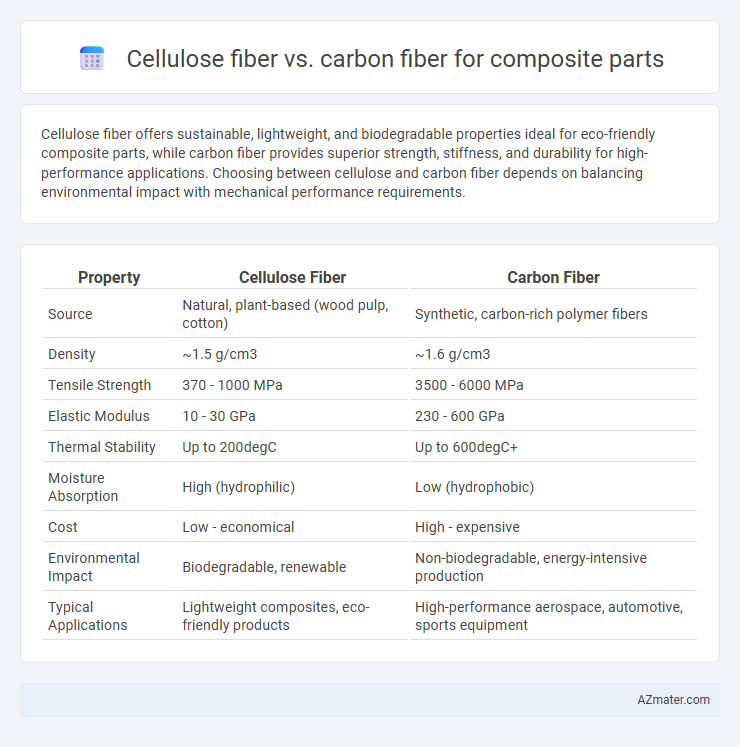Cellulose fiber offers sustainable, lightweight, and biodegradable properties ideal for eco-friendly composite parts, while carbon fiber provides superior strength, stiffness, and durability for high-performance applications. Choosing between cellulose and carbon fiber depends on balancing environmental impact with mechanical performance requirements.
Table of Comparison
| Property | Cellulose Fiber | Carbon Fiber |
|---|---|---|
| Source | Natural, plant-based (wood pulp, cotton) | Synthetic, carbon-rich polymer fibers |
| Density | ~1.5 g/cm3 | ~1.6 g/cm3 |
| Tensile Strength | 370 - 1000 MPa | 3500 - 6000 MPa |
| Elastic Modulus | 10 - 30 GPa | 230 - 600 GPa |
| Thermal Stability | Up to 200degC | Up to 600degC+ |
| Moisture Absorption | High (hydrophilic) | Low (hydrophobic) |
| Cost | Low - economical | High - expensive |
| Environmental Impact | Biodegradable, renewable | Non-biodegradable, energy-intensive production |
| Typical Applications | Lightweight composites, eco-friendly products | High-performance aerospace, automotive, sports equipment |
Introduction to Composite Fibers
Composite fibers such as cellulose fiber and carbon fiber play crucial roles in composite material engineering, offering distinct mechanical and environmental properties. Cellulose fiber, derived from natural sources like plants, provides biodegradability, low density, and cost-effectiveness, making it ideal for sustainable composite parts. Carbon fiber, composed of thin carbon strands, delivers exceptional strength, stiffness, and lightweight characteristics, essential for high-performance composite applications in aerospace and automotive industries.
Overview of Cellulose Fiber
Cellulose fiber, derived from plant sources such as wood, cotton, and flax, offers a sustainable and biodegradable alternative for composite materials with high strength-to-weight ratio and low density. It exhibits excellent mechanical properties, good thermal insulation, and moisture absorption capabilities, making it suitable for lightweight and eco-friendly composite parts. Unlike carbon fiber, cellulose fiber is renewable, cost-effective, and has lower environmental impact, though it generally has lower tensile strength and stiffness.
Overview of Carbon Fiber
Carbon fiber, composed of thin strands of carbon atoms bonded in a crystalline formation, offers exceptional strength-to-weight ratio and high stiffness, making it ideal for advanced composite parts. Its superior tensile strength and thermal resistance outperform cellulose fiber, enabling applications in aerospace, automotive, and sports equipment industries. The lightweight nature of carbon fiber composites contributes to improved fuel efficiency and enhanced structural performance compared to traditional natural fiber alternatives.
Mechanical Properties Comparison
Cellulose fiber exhibits moderate tensile strength and elasticity with superior biodegradability, making it suitable for lightweight, eco-friendly composite parts, whereas carbon fiber offers exceptional tensile strength, high stiffness, and superior fatigue resistance vital for high-performance applications. Carbon fiber composites deliver a tensile strength range of 3,500 to 6,000 MPa and stiffness between 230 to 600 GPa, significantly outperforming cellulose fiber composites, which typically reach tensile strengths around 100 to 300 MPa and moduli between 10 to 30 GPa. The mechanical properties of carbon fiber enable enhanced structural integrity and durability in aerospace, automotive, and sporting goods, while cellulose fiber composites provide cost-effective, sustainable alternatives with lower environmental impact.
Weight and Density Differences
Cellulose fiber has a density ranging from 1.3 to 1.5 g/cm3, while carbon fiber's density typically falls between 1.6 and 2.0 g/cm3, making cellulose fiber lighter in weight for composite parts. The lower density of cellulose fiber translates to reduced overall component weight, benefiting applications requiring lightweight materials. Carbon fiber offers superior strength-to-weight ratio despite its slightly higher density, but cellulose fiber composites excel in weight-sensitive designs with moderate strength requirements.
Environmental Impact and Sustainability
Cellulose fiber composites offer significant environmental benefits due to their biodegradability, renewability, and lower carbon footprint compared to carbon fiber, which relies on energy-intensive production from non-renewable petroleum sources. The lifecycle assessment of cellulose fibers shows reduced greenhouse gas emissions and enhanced end-of-life recyclability, making them a sustainable choice for eco-friendly composite parts. Carbon fiber composites, while superior in strength and durability, pose challenges in sustainability due to difficult recycling processes and higher environmental pollution throughout manufacturing.
Cost Analysis: Cellulose vs Carbon Fiber
Cellulose fiber composites offer a significantly lower material cost compared to carbon fiber, making them an economical choice for large-scale manufacturing. Carbon fiber commands higher costs due to its complex production process and superior mechanical properties, impacting overall composite part expenses. Cost analysis typically highlights cellulose fiber's advantage in reducing raw material expenses while carbon fiber delivers higher performance at a premium price point.
Processing and Manufacturing Techniques
Cellulose fiber composites typically involve simpler, low-temperature processing techniques such as compression molding and resin transfer molding due to their biodegradability and sensitivity to heat. Carbon fiber composites require high-temperature curing methods like autoclave processing or oven curing to ensure optimal fiber-matrix bonding and mechanical performance. The choice of processing influences fiber alignment, resin impregnation, and the final part's structural integrity in both cellulose and carbon fiber composites.
Applications in Composite Parts
Cellulose fiber is extensively used in automotive interior panels, packaging, and construction materials due to its biodegradability and cost-effectiveness, making it ideal for sustainable composites. Carbon fiber excels in aerospace, high-performance sports equipment, and automotive structural components because of its exceptional strength-to-weight ratio and high stiffness. Both fibers offer distinct advantages in composites, with cellulose favoring eco-friendly applications and carbon fiber suited for high-strength, lightweight demands.
Future Trends and Innovations
Emerging innovations in cellulose fiber composites emphasize biodegradability and low environmental impact, driven by increasing regulatory pressures and consumer demand for sustainable materials. Carbon fiber composites are evolving through advancements in manufacturing techniques, such as automated fiber placement and resin transfer molding, enhancing strength-to-weight ratios and enabling broader use in aerospace and automotive industries. Future trends indicate a hybridization approach, combining cellulose fibers with carbon fibers to optimize performance while reducing costs and environmental footprints in composite parts.

Infographic: Cellulose fiber vs Carbon fiber for Composite part
 azmater.com
azmater.com